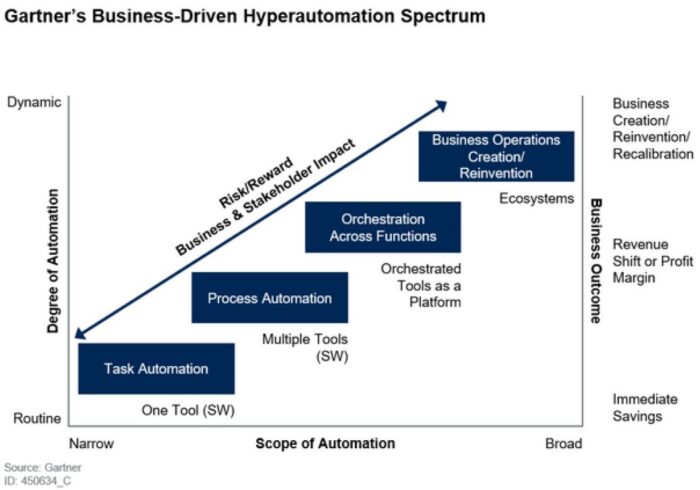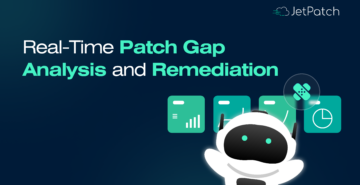Gartner recently named hyperautomation its #1 “people-centric” tech trend, with over 70% of enterprises already having hyperautomation initiatives underway. And those who don’t are scrambling to get on-trend.
Since hyperautomation involves implementing new tools and systems, as well as upgrading current staff, it comes with significant costs in the short term but promises to introduce unprecedented optimizations for the future.
Better still, it promises to help businesses rethink the way they do business, tackling the same problems in a smarter, faster, and more efficient way thanks to a range of automation technologies.
Are you on the bandwagon already? Worried about being left behind? Let’s look at what hyperautomation is, some of the ways it promises to help businesses, and the impact it’s making on best practices in IT security.
What Is Hyperautomation?
The term hyperautomation was coined by Gartner to describe “a set of business or IT process design and decisions where the scope and degree of automation delivered spans a spectrum of technologies.”
This may sound like a change merely in degree—just more automation than companies are using right now. But that’s not thinking big enough. Hyperautomation actually represents an evolutionary shift, as seen in this diagram from the Gartner report:

(Source: Gartner. Top 10 Strategic Technology trends for 2020: Hyperautomation. Published March 2020 (ID G00450634)
Beyond orchestration, hyperautomation combines multiple orchestrated systems working intelligently in unison, often boosted by a “digital twin,” meaning a fully virtualized model of the entire business, mirroring identical conditions and, as IBM explains, using “real-time data and other sources to enable learning, reasoning, and dynamically recalibrating for improved decision making.”
In the simplest possible terms, this means that the more work tasks you can move toward hyperautomation, the greater the business advantage. This is especially true because, as Gartner has emphasized again and again, the journey toward hyperautomation is not all or nothing but rather, smart iteration based on careful, business-based decision making.
Gartner further explains that hyperautomation is not one single path; it’s an iterative process that begins with recognition of the need for greater intelligence and consolidation of resources.
First and foremost, the journey must be business-driven, meaning it takes a disciplined approach to approving certain business processes that are appropriate for automation. Organizations must make choices based on their needs at any given time, carefully weighing the costs and potential benefits.
Real-Life Examples
Let’s explore a few real-life examples of automated processes at higher and higher levels of sophistication that will help illustrate the journey toward hyperautomation, based on the Gartner diagram presented above.
Task Automation
At the first stage of the journey, organizations move toward task automation. This is usually based on a single tool, automating one aspect of its performance to eliminate unnecessary work for employees. Examples of this type of simple automation include:
- An application that scans job applications for essential keywords, saving HR time
- Chatbots that provide “canned” responses to site visitors, saving tech support time
- OCR scanning to import data directly into various tools, saving manual data entry
These and other types of task automation can help eliminate human error. Today, they’re also saving time by speeding up repetitive tasks in almost every organization.
Process Automation
Going one step higher, process automation brings together multiple tools to streamline work processes. This sometimes takes the form of robotic process automation (RPA), streamlining the process of data and users who are handled by multiple systems in sequence. Process automation can connect disparate processes that typically require human intervention.
Examples of process automation include:
- Drawing on data from multiple sources like ERP or CRM to save time and generate richer user reporting
- Using a bot to consolidate common shared HR and IT functions, such as creating user accounts and access permissions for new hires
The biggest benefit of process automation is that it doesn’t require fundamental process redesign. On the other hand, this can also be its biggest failing. By allowing organizations to essentially keep doing things the way they always have, this strategy does not drive innovation. Imagine a robot built to drive a horse and buggy—it may be a better way to get to where you’re going, but it’ll never be as fast as a car.
Orchestration
Orchestration has been emerging over the last few years as an innovative way to break down silos, often through orchestration platforms. Orchestration involves tracking and managing an entire work process across multiple environments and platforms, such as apps, devices, and databases, at a greater level of sophistication than that seen for process automation.
Perhaps the most important and widespread use case for orchestration is security orchestration and response (SOAR). This creates a coordinated, well-planned approach to security threats to an organization’s digital assets.
For example, when an employee receives a phishing email, a SOAR platform may notify SIEM, EDR, and other network resources. It can also coordinate further actions using disparate tools: deploy/detonate any attachment in a sandbox, delete the email, delete further instances, bloc suspect IPs/URLs, or quarantine any possibly compromised workstation.
At its best, orchestration can improve SLAs, break down silos, and speed DevOps. However, it generally proves very costly, so most organizations have not made major strides toward orchestration.
Hyperautomation
As seen above, hyperautomation generally entails not simply doing things the way they’ve always been done and instead reinventing business operations in a way that creates value. The value of orchestration is generally boosted using a combination of AI, machine learning, natural language processing, optical character recognition, and other technologies that remove human elements from the loop and ease the passage of information from one system to another.
Examples of hyperautomation include:
- A finance system monitors user transactions and uses AI to detect potential fraud. When possible fraud is detected, the system automatically triggers a chain of responses and initiates steps toward remediation. This process could potentially save the organization millions of dollars in liability as well as build user trust and confidence.
- A blockchain-based investment exchange can create secure user wallets and comply with know your customer (KYC) regulations by using OCR and ICR technologies to import handwritten forms into various systems. It can then initiate mandatory regulatory activities, tax reporting, and more based on this information. The process cuts bureaucracy and eliminates many layers of fees while creating an extremely secure online trading community.
Unlike lower-level automation steps, hyperautomation will probably demand that organizations redesign their processes to some extent around the assumption of intelligence and silo-defying coordination between stakeholders.
The primary value creation inherent in hyperautomation stems from eliminating redundancies, that is, disparate and overlapping operations in different departments. A coordinated effort almost always proves more efficient, saves costs in the long run, and builds intelligence into all business processes.
JetPatch Supports the Journey
As we’ve seen, integrating automation into your business strategy is a key step toward hyperautomation. Gartner is enthusiastic about hyperautomation, but they emphasize in their 2019 report, “Move Beyond RPA to Deliver Hyperautomation”: “In your roadmap, clearly distinguish your use cases and their outcomes associated to your revenue, cost and risk goals.”
That means setting your priorities and deciding what can wait and what can’t.
One of the most urgent use cases for shifting toward automation should be security. Why?
- With false positives and alert fatigue, security leaves too much room for human error.
- IT departments are strained to their limit rolling out patches to a huge range of endpoints.
- Most organizations are “sitting ducks” with old vulnerabilities left hanging open (according to one report, 22% of all breaches are due to old vulnerabilities).
One simple way to close this gap and implement automation in your IT security today is with JetPatch.
JetPatch is a modern tool that supports enterprise evolution toward value creation.
JetPatch integrates your entire security environment so you can make sure there’s no overlap, meaning you’re not doing more work than necessary, and also ensure that all elements of your network, including a wide range of endpoints and environments, are covered when it comes to patching hygiene.
At its core, hyperautomation means integrating automation and optimization into your business strategy. Even if you’re not moving toward total hyperautomation right now, JetPatch is here today to help you start moving in the right direction.



